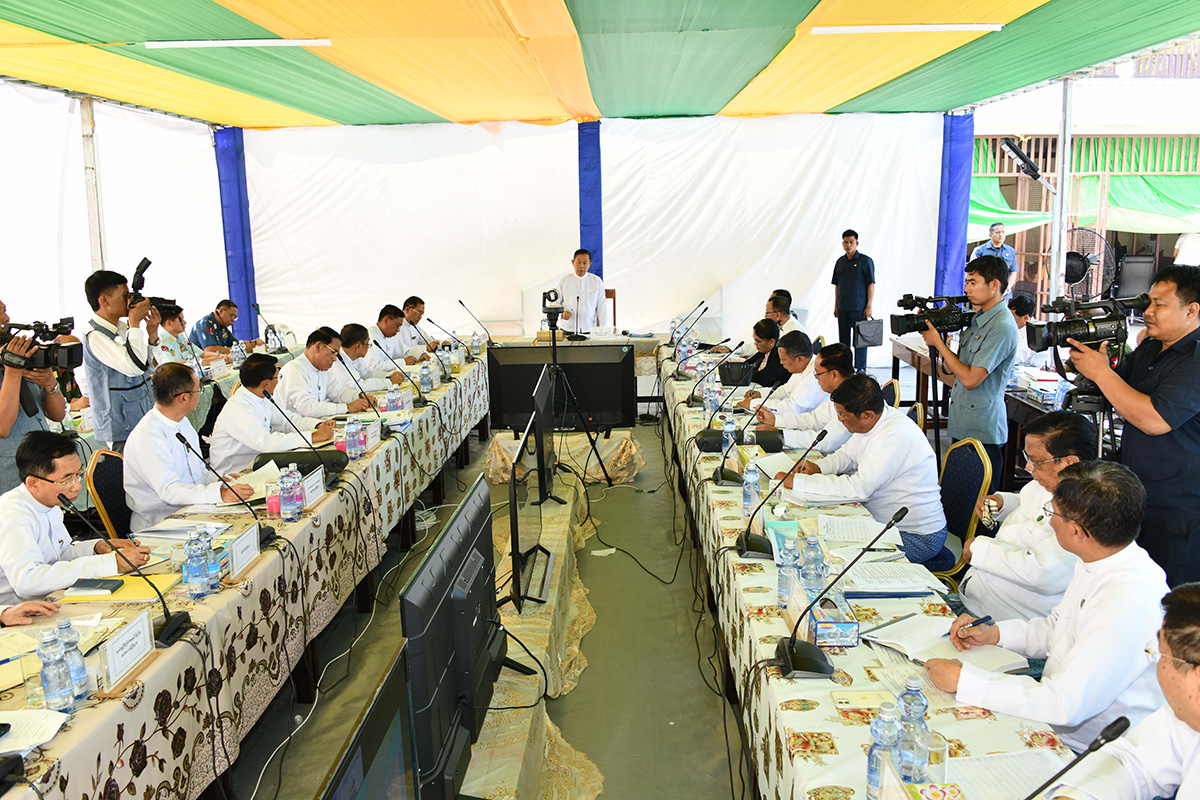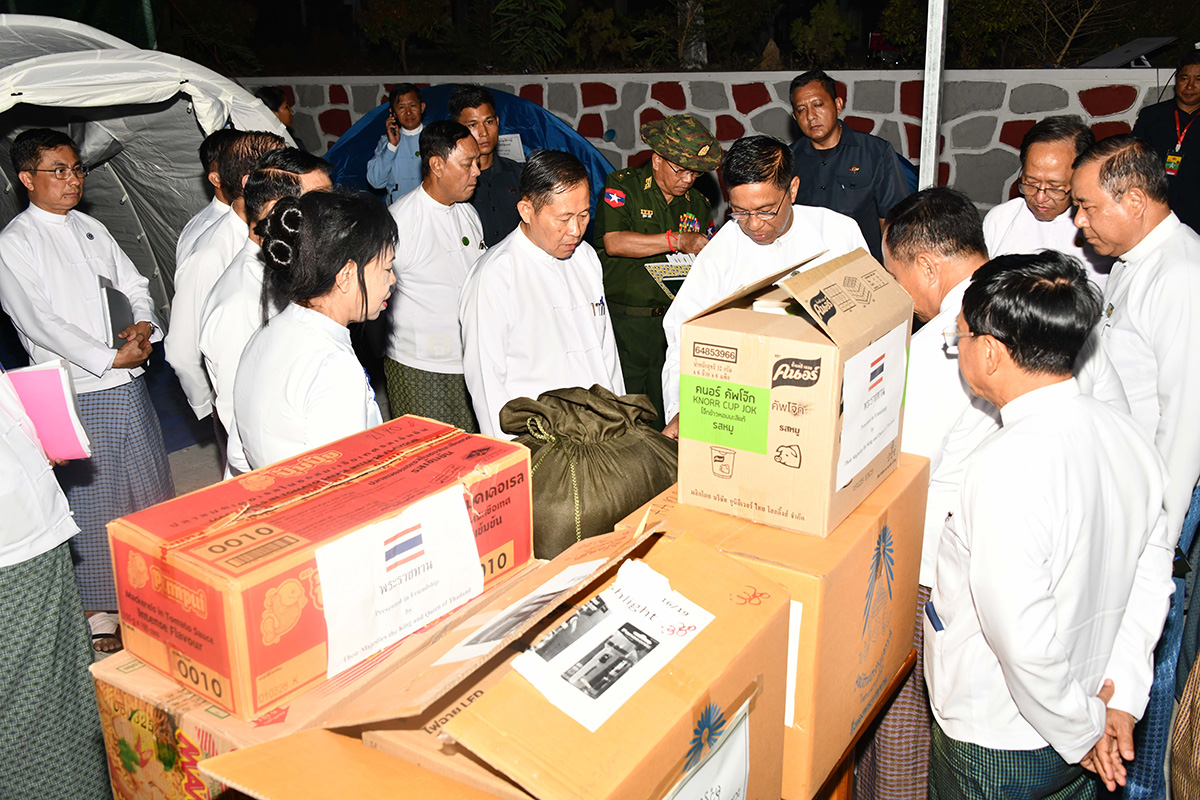The National Disaster Management Committee held its meeting at the Ministry of Social Welfare, Relief and Resettlement in Nay Pyi Taw yesterday afternoon, with an address by Chairman of the Committee Vice-Chairman of the State Administration Council Deputy Prime Minister Vice-Senior General Soe Win.
Speaking at the meeting, the Vice-Senior General delivered an address, saying that, thanks to the invitation of the Prime Minister to the international community, local rescue teams have access to the latest international rescue equipment used by foreign rescue teams, allowing for hands-on experience with advanced technology and high-tech equipment capabilities.
He noted that collaboration with international rescue teams has not only helped save the lives of affected citizens but has also allowed domestic rescue teams to share and gain access to valuable technologies and modern equipment expertise.
As of yesterday, the Vice-Senior General stressed that a total of 49 international relief flights arrived, bringing 1,915 rescue personnel and over 714 tonnes of relief and support materials. These supplies are being swiftly transported and distributed efficiently.
He recounted that the Prime Minister has also instructed that all international relief and support materials should be delivered directly to earthquake victims without being stockpiled unnecessarily, ensuring they reach those in need as quickly as possible.
He mentioned that as local and foreign well-wishers and ministries donated K126.4881 billion to be spent on rescue and rehabilitation measures in the affected areas, it is necessary to systematically manage the spending of the fund.
The Vice-Senior General emphasized that reconstruction efforts must be carried out for the damaged and destroyed staff housing, office buildings, and other structures affected by the earthquake. Arrangements must be made to ensure that staff members and their families have sufficient food and temporary shelter. It is crucial to align these arrangements with the rainy season and ensure that weather-resistant temporary or permanent structures are completed before the rainy season sets in.
He underscored that geologists, seismologists, and experts from the Engineering Council must conduct assessments to determine whether construction at the current location is appropriate. If the location is deemed unsuitable, alternative suitable land must be identified for construction.
He underlined that one of the weaknesses of the current staff housing system is that accommodations are not arranged separately for each ministry. This has led to certain limitations in coordination and communication. Therefore, during the reconstruction and relocation process, it is essential to allocate housing in a way that groups employees by ministry.
As a result, he urged attendees to effectively discuss various matters, including committee-specific tasks, ongoing activities, encountered challenges, plans, temporary relocation arrangements, and permanent settlement plans.
First Vice-Chair Union Minister for Home Affairs Lt-Gen Tun Tun Naung and Second Vice-Chair Union Minister for Social Welfare, Relief and Resettlement Dr Soe Win reported on ongoing rescue and relief operations, taking security measures in the necessary areas, arrival of relief aid, international rescue teams and medical teams, systematic deployment of rescue teams and aid, repair of roads and bridges not to interrupt communication routes, distribution of basic food items to victims, collection of data on loss and damage, and acceptance of cash and supplies from AHA Centre, international and internal well-wishers.
Committee member Union ministers and the Nay Pyi Taw Council Chairman discussed the arrival of rescue planes and aid, loss and damage of religious buildings, houses and staff housings, loss of lives of members of the Sangha, civilians, staff members and families, conducting emergency rescue operations, food, accommodation and security of affected staff members from ministries, offers of international community to conduct rescue and rehabilitation, damage of cultivable lands and dams, spreading of information about current situations in the international landscape, opening of temporary hospitals and clinics, readiness of aircraft and helicopters of Tatmadaw (Air), and further plans for rescue and rehabilitation measures.
In his response to discussions, the Vice-Senior General gave instructions on the soonest opening of temporary hospitals, arrangements for meals for members of the Sangha with temporary monasteries, plans to provide shelter to affected people and staff within two months before monsoon, systematic arrangements to hand over property to relevant families in demolishing buildings or removing debris, smooth process for international aid, systematic sending rescue vehicles with significant marks to have smooth security measures as terrorists disturb the work process, issuance of compensation for dead persons and injured people as quickly as possible, provision of foods, safe water and electricity to those people, management for personal aid of well-wishers to relevant areas, informing the people about natural disasters in time, and collection of data about donated items.
After the meeting, the Vice-Senior General viewed the display of tents, emergency electronic products, personal goods, foodstuffs and medicines donated by the international community.
Up to 6 pm on 2 April, the powerful earthquake left 3,003 people dead and 4,515 injured with 351 people missing in Nay Pyi Taw Council Area, regions and states, in addition to damage and loss of 21,783 public houses, 805 office buildings, 115 staff housing buildings, 1,041 schools, 921 monasteries and nunneries, 1,690 pagodas, 312 religious buildings, 48 hospitals and clinics and 45 acres of crops.
The rescue work committee cooperated with 37 rescue members from China (Yunnan) to save one survivor and two dead bodies, with 89 rescue members from Singapore to save one survivor and four dead bodies, with 50 Thai rescue members in searching for three dead bodies, with 106 Vietnamese rescue members in searching seven dead bodies and with eight rescue members from Turkiye in saving two survivors, totalling four survivors and 16 dead bodies.
Similarly, in Mandalay Region, a total of 167 members from Russia collaborated in the rescue efforts, resulting in the discovery of one survivor and six deceased individuals. Moreover, 84 members from China (Beijing), 116 members from China’s Blue Sky Rescue Team, and 51 members from China (Hong Kong) worked together, locating two survivors and 14 deceased individuals. Furthermore, 80 members from India participated in the process, leading to the discovery of 11 deceased individuals. In total, three survivors and 31 deceased individuals were found during the operations.
Likewise, in Sagaing Region, 50 members from Malaysia assisted in the search, locating six deceased individuals. According to reports, the rescue committee, in collaboration with 12 rescue teams from seven different countries, conducted search and rescue operations across Nay Pyi Taw Council Area, Mandalay Region, and Sagaing Region. As a result, they were able to rescue seven survivors and recover 53 deceased individuals.
MNA/TTA
#TheGlobalNewLightOfMyanmar


